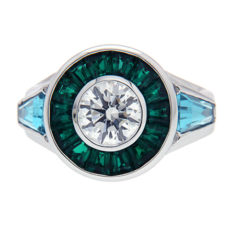Heart-Shaped Loose Diamonds: Unique and Gorgeous
Instantly recognizable and
romantic to the core, the heart-shaped diamond needs no introduction. It looks
glorious in a ring, earring, pendant, and every possible piece of jewelry. A
heart-shaped loose diamond offers better value for money compared to a round diamond
of similar size. A heart shaped
diamond will set you apart from a crowd of round diamonds. Superior
specimens of heart diamonds are even rarer as a noticeably beautiful heart must
come in 2 carats or more.
The heart shape is a modified
brilliant-cut. The distinct symbol of love, heart-shaped loose diamonds enjoy
quite a fan following as solitaire heart-shaped diamond engagement rings. While
choosing a heart diamond, symmetry is of utmost importance. Both halves of a
heart must be identically cut. The twin lobes must feature a sharp cleft in the
middle, with the wings flaunting a slightly rounded outline.
Too small a heart may not have
the same effect!
A heart-shaped diamond weighing
anywhere less than .50 carat is not an ideal choice as the shape is not easy to
perceive in smaller diamonds. The shape gets even more lost when the stone is
set in prongs. If you are opting for a smaller heart, look for a bezel setting
or a three-prong setting featuring prongs at the two lobes and the point. These
not-so-evident settings will better highlight the original outline of the heart
after it's set in a ring.
The many shapes of a heart
diamond
Different silhouettes contribute
to the final appearance of a heart diamond. From fat or wide to narrow, the
differing dimensions add to the variety of the heart shape. The classic length
to width ratio of a heart shape is approximately 1.00. A slightly narrower cut
ranging anywhere between 1.05 and 1.15 looks perfect in pendants. A wider ratio
between .85 and 1.00 looks most appealing in a solitaire. Nonetheless, when
buying a heart diamond, you must try inspecting the diamond physically. The
ideal parameters on a certificate may not always translate into a visually
enchanting stone. Ultimately, your personal preference will dictate your
choice.
Avoid the bow-tie effect
A poorly cut diamond will end up
with the dreaded bow-tie effect. It is that specific area of black shadow where
light is obstructed and fails to reflect light. Hence, it is all the more
critical to physically examine a diamond to identify this flaw. An exact
cutting proportion in a certificate may not establish the original look of a
poorly cut diamond.
In an interesting finding, it has
been witnessed that buyers often choose slightly warmer hues of a G-H diamond
than the silkiness of a colorless D-F diamond. Some of the most premium heart
diamonds feature at the higher end of the color spectrum.
The iconic heart shape is a
modified brilliant-cut. Being different from the conventional round brilliant
cut, the heart shape delivers the same sparkle without costing a bomb. The same
faceting patterns of the dazzling round determine the stone's appearance.

Comments
Post a Comment